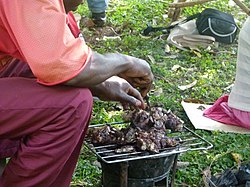
The nyama choma is a specialty of grill ed or barbecued goat meat or cow meat. Roasted meat is very popular in Tanzania and Kenya, where it is considered the national dish. [1] The expression nyama choma means "barbecue meat" in Kiswahili. [2] Nyama choma gatherings are informal with people convening around an open fire for any special occasion and at any occasion with a grill. Thus it is a social custom in much of Eastern Africa. [3]



